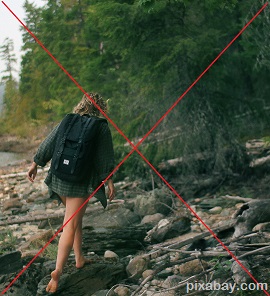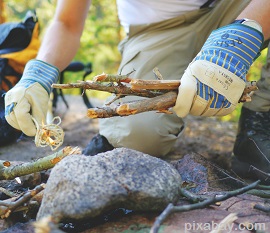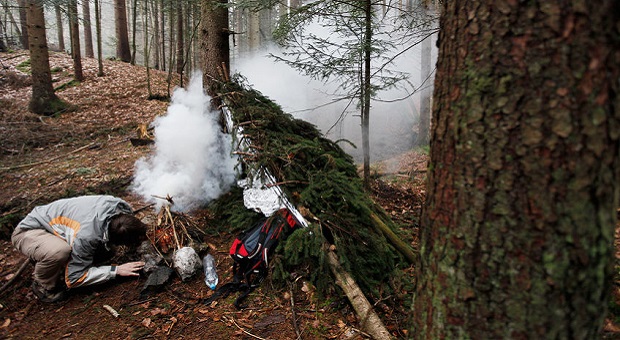You start your day thinking that you must take advantage of the last warm, sunny days of autumn and go on that long awaited and planned for hike. You won’t need much for the short journey, as you’ll be safely home by dawn. And there’s nothing that could ruin this perfect day you have in mind.
That’s unless you get distracted and separate from your group… then, step on some slippery rock and brake a bone or two… and end up isolated in the wilderness, just like the 62 year old lady that survived 9 days in these conditions. But would you?
Let’s see what you can do to make sure you are the survivor in this story, because the same conditions apply when bugging out in the wilderness when SHTF.
1. The Wrong Clothing

But there’s an important reason why the military went with long pants for jungle work instead of the classic WWII hot climate field shorts. When that first foot long poisonous centipede crawls under your open leg shorts and into those nether regions, I guarantee you will never wear ‘shorts’ of any kind again. Even to bed!
The general rule of thumb is to always dress/carry one layer warmer than you would need for the temperatures you are expecting. Removing or adding as necessary. The lady who survived in the above example had long pants, and a jacket with her which contributed to her night time hypothermia ‘salvation’. Remember ‘Cotton is Rotten’.
Yes, it’s more comfortable, but it retains the moisture too close to your skin. In a desert that might be desirable during the day when you need to stay cool, but not most other places where there are fairly large temperature swings between daylight hours right down to freezing temps after a balmy sunny day.
There is no excuse for being improperly dressed anymore with all the amazing new survival/sporting clothing and accessories they have now.
2. Inadequate Water, Food and Fire Prep.
The 62 year old woman above was smart. Even though it was only a ‘day’ hike trip and the group would come back before dark to a base campground, and the usual thing would be to bring a canteen or two of water with you for the day, in this case, she brought one of those ‘life straw’ filters which is good if you are lost for days and need to drink from dubious sources which you don’t need to get sick from otherwise.
They are small enough not to have any weight related excuses to not carry them. But I would always carry something like the aforementioned pocket Mylar Space Blankets to make a solar still, along with a cup/canteen to capture the condensing water also.
3. No Fire Making Tools or Skills.

Fires not only keep you from freezing to death but they keep the larger animal predators away and can cook your food if you have some or trapped anything, and provide a locator signal to searchers. But just having the tools does not guarantee anything. You must practice how to use these, especially in the rain.
4. Lack of Good Wilderness Navigational Skills and Equipment.
Last but certainly not the least, you should have a way to immediately call for help if you are lost or down, or trapped, so you don’t have to worry about ’surviving’.
Cell phones with GPS signaling are nice, but if you are out of range, usually only around 5 or six miles of a cell tower, then what? It’s bad enough that after all my never missed ’experience’ in the wilderness’ of the world that to me ’camping’ nowadays is a cheap motel.
If I ever again found myself really, really needing to go somewhere in the backwoods for any insane reason, I would not even un-ass my truck without my pocket size VHS Air Band compact Transceiver, with a freshly installed battery and a backup one.
Added to that my compass and area maps. With this radio I can actually get around 50 or so kilometers of LOS range which covers a pretty expanded search plane area. And if I got on a hill top I could even tune into and navigate to VOR beacons as many stations are on mountain tops and indicated on maps for location reference.
But If I was really badly stranded and waiting for rescue planes/choppers I’d tune to any aircraft I hear overhead on the Unicom or emergency frequency and talk directly to the pilots to guide them in to where I’d set up my twenty dollar 600 lumen pocket flashlight on the ground with the SOS strobe feature to guide them in.
These radios are pricey, but well worth it if you really value your life. Nowadays, of course, they have good pocket GPS satellite locators which would also be better than a cell phone, unless the cell phone had one in it.
And as for a sound signal device to any ground searchers, I’d pop a round or two from my 16 round capacity Glock 20-C that I would never leave home for the wilderness without. Which is mainly protection from big bears and other things that go ’bump in the night’. And works a lot better than a whistle.
By the way, the equipment mentioned here should be mandatory carry for even a short day hike. And it all fits on your belt or in your cargo pants and jacket/vest pockets. No need even for a small backpack if you want to travel light.
So it all comes down to having a plan before you go out to enjoy yourself. You need to plan to KNOW–NOT imagine– what to expect on your excursion and have the adequate knowledge, skills, and equipment. If you don’t, Mother Nature will make you follow her own plan. And you now know what that is.
Interested in how to improve you medical survival skills? CLICK HERE to find out!
This article has been written by Mahatma Muhjesbude for Survivopedia.








Pingback:The Four Major Mistakes Made In The Wilderness - Survivalot | October 16, 2015
|
Pingback:The Four Major Mistakes Made In The Wilderness | Freedom Newz | October 16, 2015
|
Pingback:The Four Major Mistakes Made In The Wilderness - Survival By Preparedness | October 16, 2015
|
Thom Sorensen | October 16, 2015
|
I grew up in the woods, swamps on rivers, streams, lakes and the ocean as a kid. I have done extensive amounts of backpacking and long distance (heavy whitewater canoeing) as well as Blue Water Sailing. I have done these things in all types of weather including during North-Eastern winters. I “get” most of what the article has said but I am simply not that kind of hiker / camper.
I do not and never have ever relied on any sort of electronic assistance device. GPS, Cell Phones and other similar stuff is … interesting but designed to fail when you can least afford it to and, usually means that the user has not done adequate prep work or, is likely not able to deal with a situaion that comes up where these items are disfunctional for whatever reason.
The simplest and most reliable “fire starting” device is a BIC Brand lighter. I pack, for nostalgia sake, a “Fire Stick” but … I always pack a few BIC Brand Lighters (this is NOT a place to try to save a few penies buying some other brand)
In clothing, there is no reason for not having enough. This doesn’t mean you need to have multiples of the same item (except socks) but you should have the ability to put on, or take off, several layers. The article says that “Cotton is Rotten” and I disagree heartily. Cotton and wool do get wet but it are easy to dry. Most of the “new” materials are thinner, lighter and have the potential to be wrmer but … they are plastic and plastic has its own problems. Most notably it is easy to accidentally melt important apparel whether you are drying it by the fire or even, when you are wearing it huddled next to a fire. Plastic, once it gets hot enough, can easily melt or literally cook itself onto your skin.
I have been on many “survival” trips and find that there are really only a few things you MUST have on hand. Knowledge and the ability to keep your wits about you. If you haven’t the knowledge, pair up with someone who does. If you are not very proficient yourself, a “Buddy”. That is, don’t do this kind of thing alone or with someone who will freeze at the first sign of a problem.
Whatever I choose is to carry is Well Known and Very Highest Quality. NEVER put Fancy Unknown Quality in Your “This has GOT to Work” Kit. My Typical “Basic Kit” is; High Quality Maps and Guide Books . A Quality Leatherman Type tool (NOT a cheap knock-off). A Quality Hunting Type Knife (I prefer Buck or Schrade) A decent length of lightweight but strong rope (quarter inch nylon sheathed line is my preference), A decent length of quality nylon string, a quality compass and I ALWAYS carry a “Space Blanket”. Oh … and a small First Aid kit of some sort (neosporin, advil, asprin, fabric band-aids, gauze pads, good quality medical tape, betadine swabs, ties for splints or tourniquets or …)
I suppose this makes me “Old School” but I have been a lot of places and done a lot of things and I have been at it for a long time and mostly I do things by myself. I have never gotten myself into a situation I couldn’t work my way out of … even though some of the things have been truly and honestly “hairy”. Knowledge, Common Sense, Keeping Your Head, Carefully Thinking Over whatever may come up are, to me the most important tools in your pack.
TOM | October 16, 2015
|
GREAT ADVICE!!! I CARRY A SPOT GEN3 SO IF NECESSARY I CAN BE TRACKED AT THIER SITE. THAT CHEAP FIRE STARER IS A MUST ALONG WITH A SURVIVAL FLACH LIGHT AND COMPASS. OH YES THE SPCE BLANKET TAKES NO ROOM AND IS GOOD FOR LOTS OF STUFF.
KEEP THE GOOD STUFF COMING!
TOM
Michael Waters | October 17, 2015
|
I appreciate the many practical tips your site provides.
But the claims that Obama is somehow involved in a sinister plot with ISIS to destroy America detracts from your credibility.
It might be better to stick to what you truly KNOW (practical survival), and cease with the conspiratorial speculation dressed up as absolute truth.
Sincerely,
Michael Waters
Pingback:The Four Major Mistakes Made In The Wilderness | TheSurvivalPlaceBlog | October 19, 2015
|
Pingback:10 Must Have Alternative Remedies For Preppers - Survival By Preparedness | October 23, 2015
|
Pingback:Power Grid Destruction Of The Third – And Worst – Kind - Survival By Preparedness | November 6, 2015
|
Pingback:The Four Major Mistakes Made In The Wilderness - Apocalypse Supplies | November 15, 2015
|
Pingback:How To Survive If You Get Lost In The Mountains | Survivopedia | September 5, 2016
|